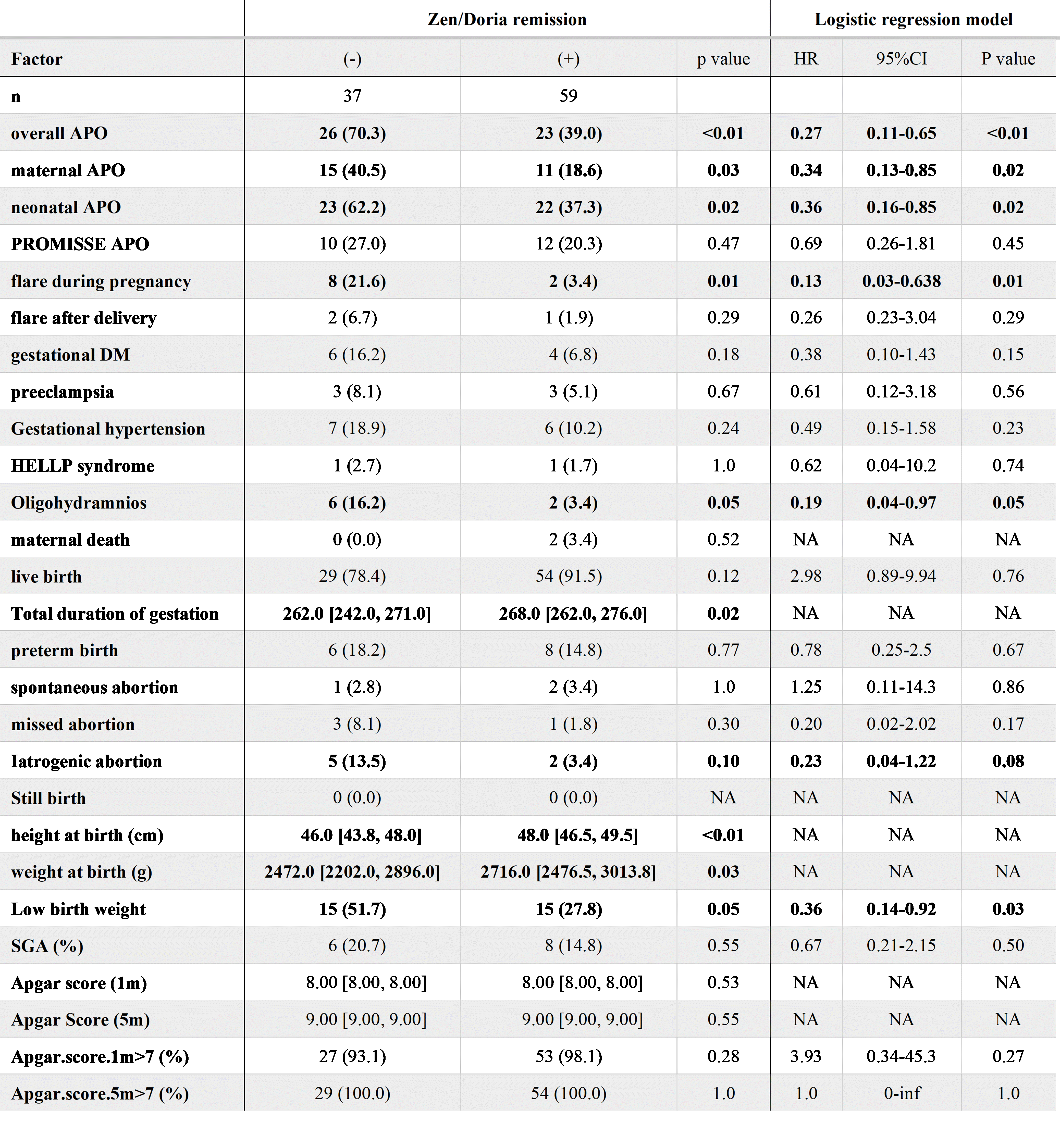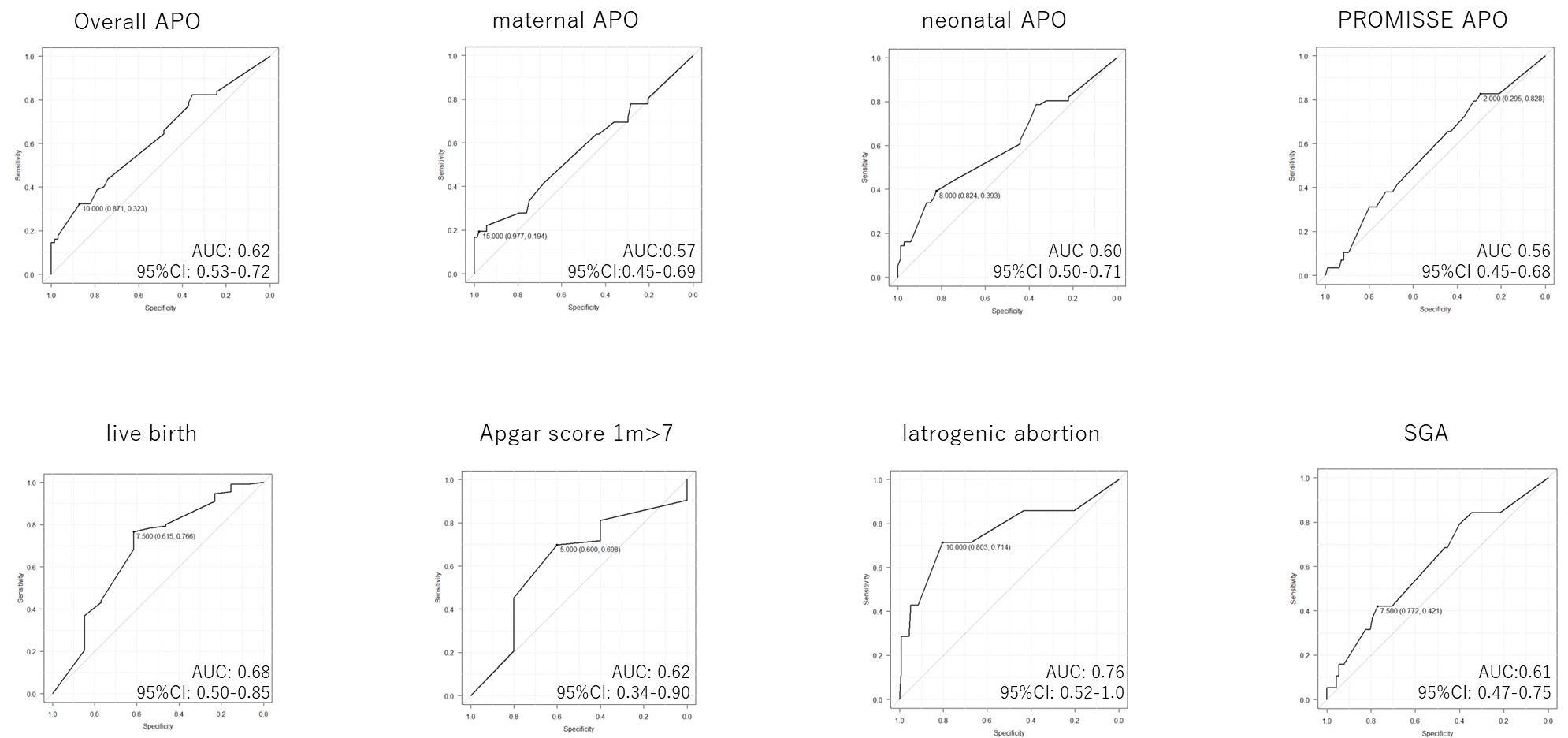Poster Session B
Reproductive health
Session: (1345–1364) Reproductive Issues in Rheumatic Disorders Poster II
1361: Effect of Zen/Doria Remission and Glucocorticoid Dosage on the Pregnancy Outcome of SLE: Retrospective Study in Two Japanese Tertiary Referral Centers
Monday, November 13, 2023
9:00 AM - 11:00 AM PT
Location: Poster Hall

Takehiro Nakai, MD
St. Luke's International Hospital
Tokyo, JapanDisclosure information not submitted.
Abstract Poster Presenter(s)
Takehiro Nakai1, Nanase Honda2, Sho Fukui3, Ayako Kitada1, Naoto Yokogawa4 and Masato Okada1, 1St. Luke's International Hospital, Tokyo, Japan, 2Tokyo Metropolitan Tama Medical Center, Fuchu-shi, Japan, 3Brigham and Women's Hospital, Boston, MA, 4Tokyo Metropolitan Tama Medical Center, Taito City, Tokyo, Japan
Background/Purpose: Achieving remission is one of the treatment targets in the lupus care and it is also important in preventing the prevalence of adverse pregnancy outcomes (APO).
Although there are reports on relationship with LLDAS/DORIS remission and APOs, little is known on the relationship with Zen/Doria remission and APO, so we conducted this study. In addition, we aimed to investigate optimal cutoff glucocorticoid dosage to predict APO prevalence.
Methods: Pregnant with SLE who was followed up at two Japanese tertiary referral centers were included in our study. We divided the patients into two groups according to the achievement of Zen/Doria remission at conception and analyzed the APO prevalence. Furthermore, we investigated the optimal glucocorticoid dosage to minimize APO.
Results: Of the 124 pregnancies, 59 achieved Zen/Doria remission at conception. Baseline characteristics except for glucocorticoid dosage and hydroxychloroquine usage at conception did not differ according to the achievement of Zen/Doria remission. (remission vs not on remission; prednisolone (PSL): 4.0 [0.0, 5.0] mg/day vs 10.0 [8.0, 11.0] mg/day, p< 0.01, hydroxychloroquine: 54.2% vs 37.8%, p=0.14)
Pregnant on Zen/Doria remission showed significant decrease in the APO ratio compared with those without. (overall APO: OR 0.27, 95%CI 0.11-0.65, p< 0.01, maternal APO: OR 0.34, 95%CI 0.13-0.85, p=0.02, neonatal APO: OR 0.36, 95%CI 0.16-0.85, p=0.02, PROMISSE APO: OR 0.69, 95%CI 0.26-1.8, p=0.45)
On the other hand, glucocorticoid dose of prednisolone equivalent≥7.5mg/day at conception was associated with the increase in APO prevalence. (overall APO: OR 2.36, 95%CI 1.07-5.28, p=0.03, maternal APO: OR1.51, 95%CI 0.66-3.44, p=0.33, neonatal APO: OR 2.69, 95%CI 1.22-5.94, p=0.01, PROMISSE APO: OR 1.62, 95%CI0.68-3.89, p=0.28)
ROC curve also showed that prednisolone dosage >7.5mg/day was related to the decrease in live birth rate (AUC 0.68, 95% CI 0.50-0.85, sensitivity 0.77, specificity 0.62)
Conclusion: Achieving Zen/Doria remission can be a clinical target to reduce APOs in patients who wants to be conceived. In addition, if clinically feasible, reducing glucocorticoid dosage to less than 7.5mg/day before conception can be another treatment target.

.gif)

T. Nakai: None; N. Honda: None; S. Fukui: None; A. Kitada: None; N. Yokogawa: None; M. Okada: AbbVie/Abbott, 6, Eli Lilly, 6, Pfizer, 6.
Background/Purpose: Achieving remission is one of the treatment targets in the lupus care and it is also important in preventing the prevalence of adverse pregnancy outcomes (APO).
Although there are reports on relationship with LLDAS/DORIS remission and APOs, little is known on the relationship with Zen/Doria remission and APO, so we conducted this study. In addition, we aimed to investigate optimal cutoff glucocorticoid dosage to predict APO prevalence.
Methods: Pregnant with SLE who was followed up at two Japanese tertiary referral centers were included in our study. We divided the patients into two groups according to the achievement of Zen/Doria remission at conception and analyzed the APO prevalence. Furthermore, we investigated the optimal glucocorticoid dosage to minimize APO.
Results: Of the 124 pregnancies, 59 achieved Zen/Doria remission at conception. Baseline characteristics except for glucocorticoid dosage and hydroxychloroquine usage at conception did not differ according to the achievement of Zen/Doria remission. (remission vs not on remission; prednisolone (PSL): 4.0 [0.0, 5.0] mg/day vs 10.0 [8.0, 11.0] mg/day, p< 0.01, hydroxychloroquine: 54.2% vs 37.8%, p=0.14)
Pregnant on Zen/Doria remission showed significant decrease in the APO ratio compared with those without. (overall APO: OR 0.27, 95%CI 0.11-0.65, p< 0.01, maternal APO: OR 0.34, 95%CI 0.13-0.85, p=0.02, neonatal APO: OR 0.36, 95%CI 0.16-0.85, p=0.02, PROMISSE APO: OR 0.69, 95%CI 0.26-1.8, p=0.45)
On the other hand, glucocorticoid dose of prednisolone equivalent≥7.5mg/day at conception was associated with the increase in APO prevalence. (overall APO: OR 2.36, 95%CI 1.07-5.28, p=0.03, maternal APO: OR1.51, 95%CI 0.66-3.44, p=0.33, neonatal APO: OR 2.69, 95%CI 1.22-5.94, p=0.01, PROMISSE APO: OR 1.62, 95%CI0.68-3.89, p=0.28)
ROC curve also showed that prednisolone dosage >7.5mg/day was related to the decrease in live birth rate (AUC 0.68, 95% CI 0.50-0.85, sensitivity 0.77, specificity 0.62)
Conclusion: Achieving Zen/Doria remission can be a clinical target to reduce APOs in patients who wants to be conceived. In addition, if clinically feasible, reducing glucocorticoid dosage to less than 7.5mg/day before conception can be another treatment target.

Table 1: achievement of Zen/Doria remission and its relationship with adverse pregnancy outcome
.gif)
table 2: glucocorticoid dosage and its relationship with adverse pregnanyc outcome

Figure 1 Receiver operating characteristic (ROC) curve for glucocorticoid dosage at first trimester to predict each adverse pregnancy outcomes
T. Nakai: None; N. Honda: None; S. Fukui: None; A. Kitada: None; N. Yokogawa: None; M. Okada: AbbVie/Abbott, 6, Eli Lilly, 6, Pfizer, 6.



